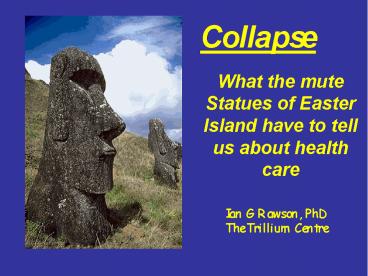Collapse - PowerPoint PPT Presentation
Title:
Collapse
Description:
The ancient Maya, Easter Islanders, Greenland Norse, Anasazi, and other cultures ... The Maya also competed by building large temple complexes, and requiring the ... – PowerPoint PPT presentation
Number of Views:147
Avg rating:3.0/5.0
Title: Collapse
1
Collapse What the mute Statues of Easter
Island have to tell us about health care
Ian G Rawson, PhD The Trillium Centre
2
- Many societies have disappeared from their
original locations, leaving only traces of what
their lives were like while they lived there. - The ancient Maya, Easter Islanders, Greenland
Norse, Anasazi, and other cultures leave only
subtle clues as to why they abandoned their
traditional homes. - Jared Diamond, in his book, Collapse, chronicles
the decline of these civilizations and finds that
the causes were complex, but often shared several
common themes. - Primary among these is the over-exploitation of
resources in a fragile environment, and a failure
to interpret the danger signals which the
ecological environment sends. - The same may be said about health care in the US
today.
3
Cooperation Fragile Ecosystem
Overexploitation
4
The Easter Islanders arrived from Polynesia and
found an island which looked very similar to the
ones they had left. Except it wasnt. The soil
was shallow and plants had a fragile
existence. The Easter Islanders built statues of
their ancestors, moai, near the coasts, rolling
them from the quarries over logs. The trees were
not replanted, and eventually the last one was
cut, and the deforestation affected the climate,
reducing crop production. As the residents
faced starvation, they abandoned their island
home. Diamond asks What was the Easter
Islander thinking when he cut the last tree on
the Island? How could the residents commit
ecocide, in which ecological collapse leads to a
threat to the population? Is there an analogy
with health care, with a limited resource base
(insurance) and continuing assaults on the
ecology (reimbursement, malpractice)?
5
Competition Ecocide Depopulation
6
- Much of the stress on the environment came from
competition among the social groups to build
larger and more complex statues, hoping to
appease the spirits and return the islands
productivity. - The expenditure of caloric resources in
unproductive activities only exacerbated the
imbalance between the population and the
environment. - The pursuit of a miraculous salvation also
impeded the development of more appropriate
exploitation techniques.
7
Competition Edifice Complex
8
- The Maya also competed by building large temple
complexes, and requiring the production of
foodstuffs for economically unproductive workers. - Eventually, food production in the peninsula
declined so it did not support the needs of the
residents, and competition for food increased,
turning into violence.
9
Fragile Ecosystem Climate Cycles
10
- Instead of attempting to adapt to changing
environments, the Maya attempted to control the
environment through spiritual means. - As the climate cycles in the Yucatan region
passed through a series of droughts, more temples
were built and ceremonies were conducted to
change the course of nature. - Can we see some similar trends in health care,
in which a failure to interpret trends leads to
unproductive and competitive strategies, rather
than adapting to the changes?
11
Competition Conflict
Ecocide
12
- Ceremonial games were held between neighboring
groups, and as the skulls on the wall of the ball
court show, losing could be a dangerous
proposition.
13
Fragile Ecosystems Climate Cycles
14
- The Norse came to Greenland seeking new lands,
and thought that they had found a familiar
environment. - Greenland was not similar to their homeland it
is a harsh and unforgiving environment, and the
Norse lived through a number of climate cycles of
increasing cold. - This affected their food production, and
eventually those who could not leave the island
starved, or possibly reverted to cannibalism.
15
Imported Culture Overexploitation Class
Conflict
16
- The leaders of each settlement group controlled
the resources, keeping much of them for
themselves, and leaving the other residents with
little to live with. - In trying to maintain a traditional way of life
with herds of cattle, which destroyed the shallow
soil, the Norse changed the ecology and sowed the
seeds of their own destruction. - Is health care pursuing traditional strategies
to exploit the environment, instead of adapting
to the cycles of change? And what impact might
this have on the populations we serve, especially
the most vulnerable?
17
(No Transcript)
18
- While the Norse and their cows were starving,
the Inuit residents of coastal Greenland pursued
their traditional food production techniques, and
maintained a balance between their population and
the ecology. The Norse disappeared from
Greenland, but the Inuit remain today.
19
Competition Fragile Ecosystem Over-Exploitation
Ecocide?
20
- Health systems continue to build dramatic new
buildings, competing with other systems for
control over services to populations, usually
with adequate health insurance. - Is this a productive use of scarce resources?
What impact does this have on the environment of
a diminishing economic resource base?
21
ISEP Its Someone Elses Problem
Suppression of doubt and critical thinking
Refusal to draw inferences from negative
signs Persistence in error
22
- Several tendencies guided the Maya, the Easter
Islanders, the Greenland Norse and others toward
self-destruction. - Each individual told themselves that whatever
was happening was not their problem, but someone
elses. - As the climate cycles became more extreme, the
populations and their leaders continued to
persist in their belief that the trend was not
increasingly dangerous. - Instead of shifting their exploitative
techniques to methods which adapt to the
environment, they continued their pursuit of
traditional, and destructive, techniques. - Are there analogies in health care today?
A supression of doubt? A
persistence in error?































